There would be no point in reading this unless you’re already familiar with Cowboy Bebop. (If you need an introduction or a refresher, click here.) If you’re feeling ambitious, you also might want to read Georges Dumezil’s philological treatise Mitra-Varuna: An Essay on Two Indo-European Representations of Sovreignty. (It’ll probably take you a couple of weeks — no worries, I can wait.) Okay, you’re back? Good.
Georges Dumezil devoted his career to reconstructing proto-Indo-European society through comparative readings in folklore and mythology. His big idea was that you can figure out Proto-Indo-European religious and political structures through the same process that lets us use the similarities and differences between the Latin, Old Norse, and Sanskrit words for mother — māter, móðir, mātár — to derive the Proto-Indo-European word that they all derive from: *meHtér, however that’s pronounced. (The asterisk, by the way, means that we think a word like this ought to exist, but it’s never been observed in real life. I like this idea, and think that it should be applied outside of linguistics, so that you’d get things like *understated-Nicolas-Cage-performance and *reasonable-discussion-of-politics-on-the-internet.)
Dumezil’s most famous claim is that Indo-European society had two complementary concepts of political leadership, which are represented in ancient cultures by a linked pair of kings or gods. Mitra and Varuna in India. Tyr and Odin in Scandanavia. Nuada of the Silver Hand and Lugh Samildanach in Ireland. In Rome, there were actually three pairs: the gods Dius Fidius and Jupiter, the legendary kings Numa and Romulus, and the military heroes Gaius Mucius Scaevola and Horatius Cocles. All of these, claims Dumezil, are reflections of an older pair of proto-Indo-European deities, *Tiwaz, the priest-king, and *Wodhanaz, the magician-king.
(The takeaway here is that proto-Indo-European religion was metal as f__k.)
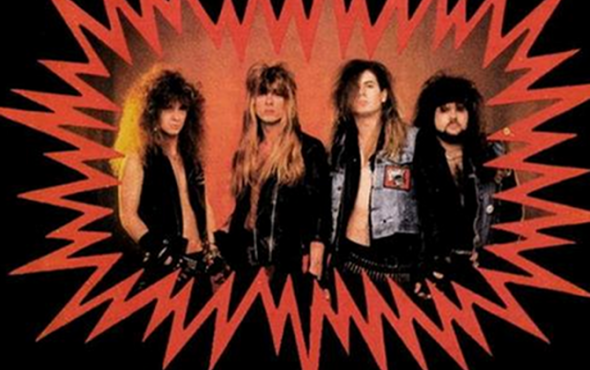
Live this Sunday from the Nassau Colosseum, it’s *Tiwaz the Priest King! j/k this is Pantera; Pantera used to dress like this.
The magician-king, Dumezil writes, “covers that which is inspired, unpredictable, frenzied, swift, magical, terrible, dark, demanding, totalitarian, iunior, and so on; whereas the other (the Mitra side) covers that which is regulated, exact, majestic, slow, juridical, benevolent, light, liberal, distributive, senior, and so on.” Priest-kings are associated with justice, duty, and family; their attribute is gravitas. Magician-kings with are associated with chaos, violence and fertility; their attribute is swiftness. Priest-kings are old, magician-kings young.
Now, I’m no philologist, so I don’t care to engage with the core of Dumezil’s argument. But I will say this: regardless of how well Dumezil’s archetypes describe ancient European religions, they do a damn fine job of describing every buddy cop movie ever made.
And oh my GOD do they ever describe Spike and Jet.
For instance, Priest-kings are associated with “conservation,” magician-kings with “fecundity,” which for Dumezil seems to mean death, growth, and rebirth. In Cowboy Bebop, Jet protects the characters he has interactions with (such as Mei and Alisa), while Spike tends to teach them things and get them killed (Rocco, Gren). Priest-kings rule in times of peace, magician-kings in times of tumult. The BeBop is Jet’s ship, he has the final word about where they go and when, but when it comes to fighting, it’s Spike that sets the agenda. We might fairly say that Mitra governs techne while Varuna governs gnosis (INT and WIS respectively, for my D&D chuckleheads out there), and sure enough, throughout the series, Spike has an affinity for magic and intuition, and is subtly opposed to technology, while Jet is a hacker and a mechanic who takes offense at supernatural mumbo-jumbo. Spike guesses the Space Trucker’s name (a magical, fairy-tale gesture), consults with fortune tellers, intuits the nature of the demon harmonica player’s bargain while ignoring Jet’s attempts to get at the same thing by science… Jet, on the other hand, tries to understand things rather than simply knowing them: he talks about the temporal matrix in harmonica boy’s ring, he tracks down Londes in the hospital. (I’ve been talking about Spike and Jet’s magic/science binary all along — I just didn’t realize until I read Dumezil that they were representing stone-age archetypes.) Both of Dumezil’s archetypes are associated with contracts and debts, although in rather different ways: the priest-king oversees debts that are paid, the magician king punishes debts that are unpaid. So Jet gets payback for his arm when he kills his partner, he makes restitution to Alisa, he fulfills his obligation to Mei’s father. Spike, on the other hand, punishes people who have violated natural law: Harmonica boy, Pierrot… I devoted a whole post to this tendency here.
Cowboy Bebop even reflects some aspects of the Mitra-Varuna archetypes that Dumezil doesn’t cover! Take the animal symbolism, for instance. Dumezil spends a lot of time talking about the magician-king’s association with horses. But he doesn’t bring up the magician-king’s more tenuous link to birds (Varuna “knows the track of birds that fly within the air,” Odin has two raven servants that fly around the world spying for him), or the priest-king’s ambivalent association with dogs (the priests appointed by Numa were not allowed to touch or name dogs, the Norse god Tyr lost his arm to a wolf, the Celtic Nuada is always pictured with a dog). Meanwhile, in Cowboy Bebop, Jet’s nickname is “The Black Dog,” and he’s Ein’s de-facto caretaker throughout the series. Andy and Vicious — both obvious doubles for Spike — have a pet horse and a pet bird respectively… and Spike himself has an affinity for cats, the symbolic anti-dogs. It doesn’t line up perfectly, but it lines up better than it should, is all I’m saying.
And if that’s not enough evidence, try this one on for size: over and over again, in every appearances in all the mythologies that Dumezil considers, the Priest-King is marked by a deformity of the hand.
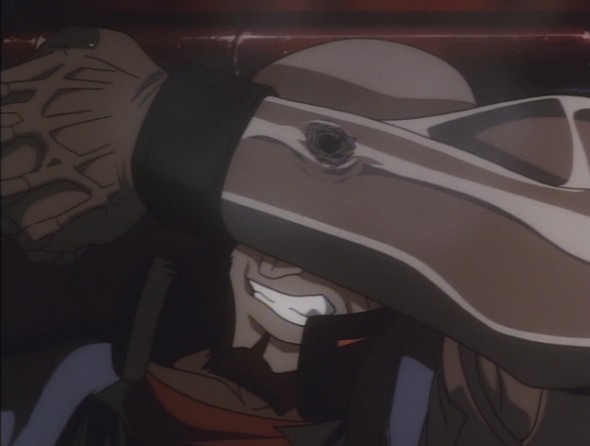
The Priest-King: The One-Handed God
And the Magician-King is marked by a corresponding deformity of the eye.
Jet’s robot arm is pretty obvious, of course. Spike’s robot eye, less so — I’m pretty sure that when he tells Faye about it in the final episode, it’s supposed to be a surprise to the audience as well. (There are definitely closeups of Spike from earlier in the series where there’s no visible difference in the color of his eyes — in fact, I couldn’t promise you that the difference is visible in any shot at all other than this one.) But it’s not like the writers pulled it out of their butts Lost style, either. They teased it for a while: in “Jupiter Jazz,” Gren talks about the mismatched color of Spike’s eyes, and in “Pierrot le Fou” the killer freaks out because something about Spike’s face reminds him of the cat from the lab that he was tortured in… and the cat very clearly had a robotic eye. Spike’s eye, then, isn’t just some random piece of character design. Arguably it isn’t part of his character design: as it’s not part of how he’s usually drawn. Rather, it’s a reveal: when we finally get to see it, and hear Spike explain it, we’re getting narrative closure. And that closure is a lot more profound if we understand the underlying symbolism. “Oh, I get it! He’s Odin.”
Let’s talk about the specific nature of Spike’s eye injury. We’re meant to understand that when Spike left the syndicate, he got shot in the face and ended up with a robot eye that periodically malfunctions and shows him flashes of his old life with Julia and Vicious. (Like I mentioned in the last post, this means that the cutaway flashbacks that we’ve seen at various points over the run of the series — before the opening credits of the first episode, for instance, or during the falling-out-the window sequence in “Ballad for Fallen Angels,” for instance — are quite possibly supposed to be diegetic cutaway flashbacks: in these moments, we are actually seeing what Spike sees.) So we’ve got an amputated eye that shows him visions. And then there’s this image from the end of the opening credit sequence, which sort of looks like a camera lens adjusting focus in a deep pool of water…. this is presumably an extreme close-up on the mechanical eye in action.

There’s also a certain underwater quality to this image, from episode six, which presumably shows the doctors installing Spike’s eye. Yes?
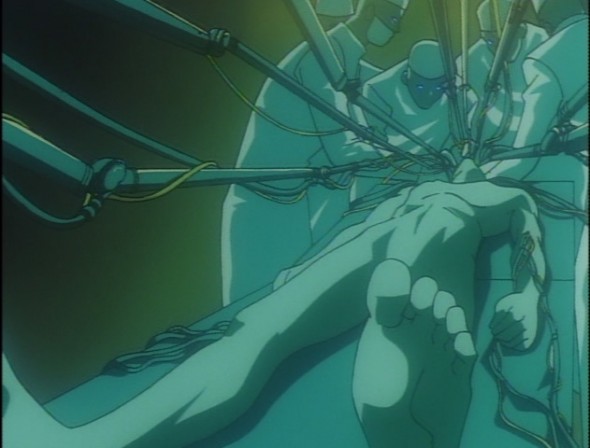
Now, archetypes aside, underwater-ness is always associated with the past in Cowboy Bebop, so that pretty much makes sense already. But would it make even more sense when we remember that Odin, Norse mythology’s version of the magician-king, plucked out his eye and cast it into the spring that feeds the roots of the world-tree, in exchange for visions of the past, present, and future? The oldest accounts of this are very vague — but some modern retellings have it that Odin still sees through this eye: that it shows him the visions as it floats there in the mímisbrunnr.
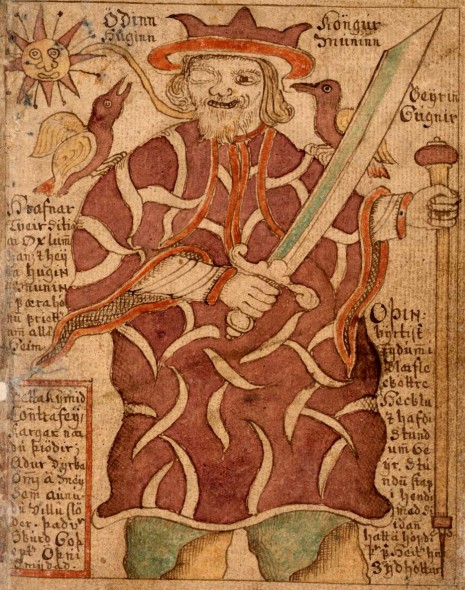
Odin, I know | where thine eye is hidden
Deep in the wide-famed | well of Mimir
Mead from the pledge | of Odin each morn
Does Mimir drink: | would you know yet more?
And doesn’t this put a new slant onto Spike’s relationship with his past, and the grimly fatalistic way he marches off to his death in the final episode? And even on the way that he and Vicious seem fated to kill each other simultaneously at the end of the show?
Understanding the Mitra-Varuna archetypes doesn’t just help us understand Spike and Jet as characters. It also helps us understand the two basic plots that drive 90% of all Cowboy Bebop episodes. The first of these is the noir plot, in which a person is haunted, and eventually destroyed, by an old debt — some tragic secret out of their past. The second is the Bonnie and Clyde plot, in which two young lovers on the run rip off a powerful organization, and then live fast and hard until they inevitably are brought down. Really, these are two sides of the same coin: in one, the protagonist tries to move towards the traumatic past, in the other, he/she tries to move away from it. One is about the price of paying our debts, one about the price of not paying them… which are the Mitra and Varuna aspects, respectively, of contracts. So it looks like these archetypes are woven into the fabric of the show on a very deep level.
I’m totally serious about all of this, by the way. I know that sometimes here at OTI we are kind of kidding/not-kidding when we interpret pop culture through highfalutin’ philosophical frameworks. But not this time. I wouldn’t put serious money on the proposition that Watanabe et. al. were consciously drawing on Dumezil, but I think it’s more likely to be true than not. I mean, how else could these patterns have come from? It could just be a coincidence… but man, that would be a pretty thorough coincidence. It could be that these archetypes are built into the human psyche in a Carl Jung, collective unconscious kind of way, right down to the eye-hand business and the animal symbols. But if that were the case, we’d be seeing these images everywhere we looked. And you don’t.
I mean, you do get it quite clearly in Lord of the Rings, with Saruman’s symbol of the White Hand and Sauron’s symbol of the Red Eye. Saruman, the Mitra figure, is associated with technology and with the fulfillment of contracts (he tries to bargain with Sauron and hopes to extend the same bargain to Gandalf), and tries to take over Rohan by manipulating the political process. And note that although Saruman is literally a magician, he ends up losing his magic. Sauron, on the other hand, is more totalitarian (“he does not share power”), more swift, more supernatural, more overwhelming, more of a trickster. He’s associated with horsemen (the nine riders) just as Varuna is associated with centaurs. When he or one of his minions appears on the battlefield, his enemies are paralyzed with fear; this is an attribute of the Varuna figure in both Norse and Roman myth. (Amazingly, a quick search of google scholar suggests that nobody has made this connection yet, despite the fact that Tolkien, as a competent philologist working in the first half of the 20th century, must have been reading Dumezil. So… yeah. Free master’s thesis, I guess, if anyone wants it.) But other than that, you’ve got True Grit, (for which see this Slate article), and Cowboy Bebop… and that’s about it.
Anyway, intentional or not, the symbolism is there. And as a result, watching Cowboy Bebop after reading Dumezil is slightly richer experience. Which is saying something. The experience was already pretty damn rich.
We should mention in passing here that Dumezil brings up a third archetype, Indra the warrior god, who is opposed to both Mitra and Varuna. Indra’s important properties, for Dumezil, are as follows: 1) His followers form unofficial professional societies (warrior brotherhoods, etc.) that offer an alternative to the state’s normal social organization. 2) He offers the possibility of a clean break from the past, severing the bonds fastened by the magician-king, and dissolving the contracts officiated by the priest-king, and erasing the debts so important to both. Dumezil brings up a number of ancient examples of the Indra function, but the best example is probably the French Foreign Legion as it functioned during his own lifetime. Now, Dumezil doesn’t offer anything like a detailed investigation of the Indra/Ares/Thor archetype, at least not in that book. But perusing Wikipedia, I was REALLY SUPER FREAKING INTERESTED to learn that Indra is associated with water, hot-temperedness, and the color yellow. Just saying, is all.
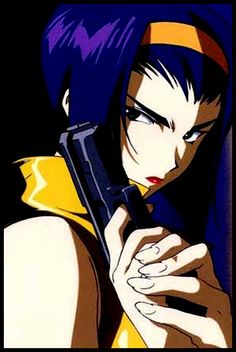
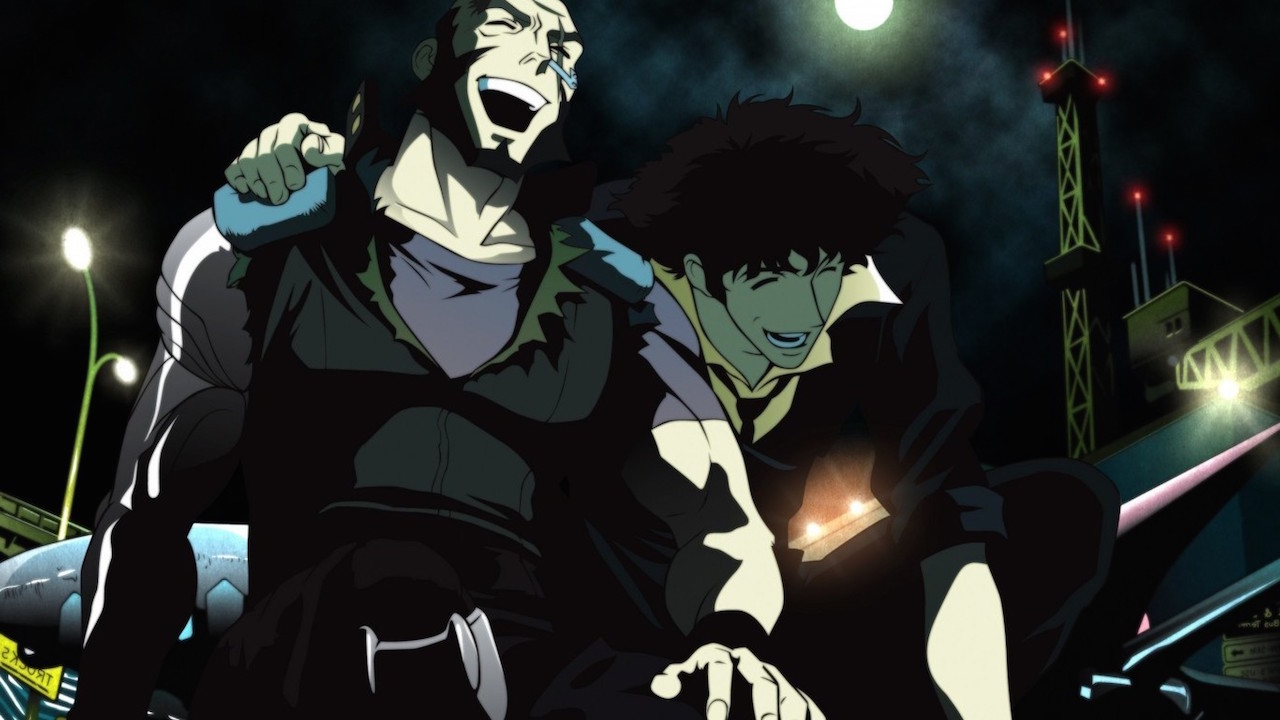
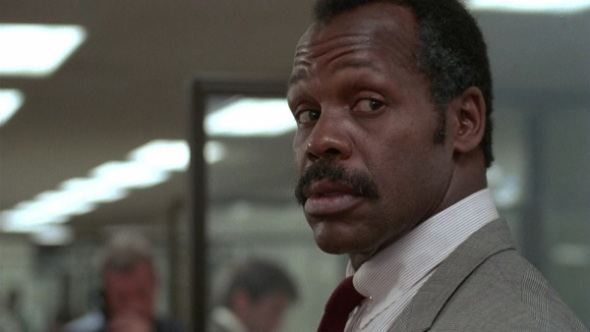
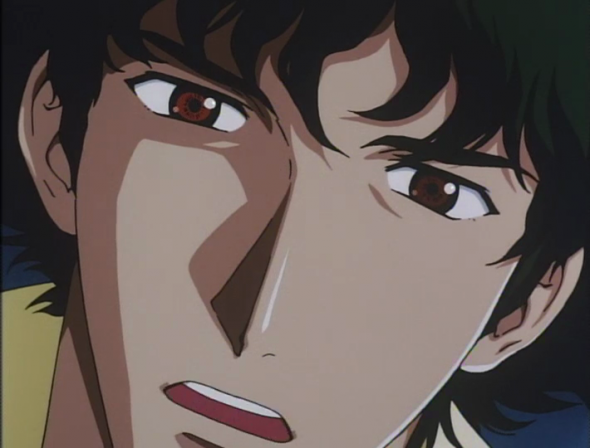
Never stop writing these.
It’s been a while since I was at a point in my life where I was mainlining a ton of anime, but I remember noticing the lost eye/arm thing across several, often combined with characters who are brothers or reflections of each other, Trigun and Evangelion being the only ones that spring to mind now. But you’re right, the sheer number of attributes and pairings makes Bebop in particular especially fertile for overthinking, and they line up here much better than in any of the other shows.
It’s worth noting that Yagyu Jubei, famous swashbuckling historical-ish character from samurai times, is often depicted with an eyepatch. Also, I always wondered if badass anime characters with big or frizzy hair, like Spike, had that hair as a reference to Miyamoto Musashi, who is sometimes described as having messy and tangled hair, since bathing would give his enemies a chance to attack him without his sword in his hand. But that might be actual overthinking.
Now, does all this arm/eye stuff mean Lord Nelson is some kind of perfect Mitra/Varuna synthesis?
Huh! Now I need to watch a bunch of anime for research. (I actually have watched very, very little — an embarrassing oversight for someone who’s setting himself up to be, if not the world’s leading expert on Cowboy Bebop, at least it’s most long-winded expert.)
After pulling the trigger on this, I remembered that there’s a recent arc of Phil and Kaja Foglio’s Girl Genius where they run across an order of monks who are led in peacetime by this guy, and led in times of war by this guy. What other examples did I miss?
I wouldn’t say you “missed” any necessarily–most other examples don’t have the strong dichotomies of bird/dog, magic/tech, etc etc.
Sort of a spoiler I guess, but the protagonist of Trigun has a cybernetic arm that conceals a gun, and many other characters in the show have robot or gun arms and are foils of him to varying degrees. The arm he lost was actually attached to one of the main villains we meet later, who also has the “hair always covering one eye” thing you see in a lot of anime. Not sure if that relates at all to the eyes that are legit lost or replaced. Then there’s a single episode villain with an eye patch that…somehow?…let’s her move at super speed via hypnosis. It’s not super well explained.
Several times in Evangelion characters will get injured in fights then come out of the hospital with a bandaged eye or arm or both. A few times arms get knocked the hell off in fights, or just fall off for complex reasons that are outside the scope of this comment. In the movie that closes the series, one robot pilot loses her eye and her arm just splits in half, because she is so in-sync with her robot that she takes its damage with her own body.
More recently there is Mushi-shi, a very cool low-key show about a kind of traveling Shinto shaman who is an expert in the little spirits that affect our lives and environments, called mushi. (It’s a little bit like a medical drama, except he uses magic to diagnose and cure spiritual issues.) His bangs are always covering his empty socket, and there’s an episode all about how he lost his eye, having to do with mushi that live in light, as well as something to do with a river…it’s been a while.
There’s a lot that, I think, can just be chalked up to the eye and the arm being neat places to take battle damage, which then give you neat character designs, but it happened enough that after I watched Bebop I started looking for it. None of the others really come close to Bebop for resonating with all the aspects of Mitra/Varuna, as far as I’m aware.
There’s a LOT of this kind of thing sprinkled throughout anime/manga. A few examples off the top of my head:
-Berserk where the main character Guts has both a mechanical cannon hand, and is and an missing eye.
– Full Metal Alchemist (in its various incarnations) where Ed has both a metal arm and leg
– Akira (Tetsuo) looses an arm which he replaces with some kind of mechanical amalgam
– Hellsing’s Seras replaces a lost arm with some kind of shoggoth/vampire hybrid
Mechanical / Magical eyes are also big in the genre with Code Geass, Spriggan, Ghost in the Shell, Naruto and Death Note all featuring them in one form or another.
I can’t think of anything that lines up as well as Beebop, but anime/manga is lousy with these kind of losses replaced by technology or willpower/destiny enabled upgrades.
This article made my day. Thanks, Stokes!
Amen. Bebop is dead! Long live Bebop!
If you’re going to watch more animes then, I guess you could be interested in Samurai Shampoo, that if I’m not mistaken is a posterior work of the creators of Cowboy Bebop. Quite good and with an interesting set of lead characters, more now that I’ve read this article…
Autocorrector trick, it’s *Shamploo
Champloo, actually–I was going to mention it. It’s very much simpler and light-hearted than Cowboy Bebop, and the dualism of the two main samurai warrior characters, Jin and Mugen, is much more transparent and explicit. So Stokes, I think that supports your reading of Cowboy Bebop here (which was already convincing).
BTW, I’m told Arthur Hocart, in Kings and Counselors, extends this Priest King-Magician King duality outside of Indo-European mythology, I believe he names the two types Sun King and Storm King.
So when you say that you do not see this dichotomy everywhere, were you just kidding about the buddy-cop movies? Or did you mean there are only a limited number of rich, full representations of this dichotomy?
Well, you don’t often see the physical accoutrements of the archetypes: the totem animals and the hand-eye coordination (hahaha). If you just turn the archetypes into personalities, then all the buddy-cop movies count — but Riggs doesn’t usually end up losing an eye, and Murtaugh only gets shot in the arm because we all think that arms are effectively bulletproof.
So, Nick Fury’s the Magician King and Bucky’s the Priest-King?
“Mitra governs techne while Varuna governs gnosis”.
Techne means art/skill and gnosis means knowledge/wisdom so you got 1/2 right with your metaphor about DnD, just sayin’.
This is really compelling stuff! I’ve always loved the Cowboy Bebop content here.
More fuel for the fire: A nickname of Spike’s in several episodes, associated with mystical, wise mumbo jumbo and given to him to him by the Native America/Martian , is Swimming Bird.
Also, and there is another connection in Anime that came o my mind, which is very cool and also stupid. Yu go Oh consciously evokes this trope with Yugi and Kaiba, linking them to ancient reincarnations of a Pharaoh and Magician respectively, with similar outlooks and a tenuous friendship/rivalry very evident. Yugi even always tries to right wrong and save people, while Kaiba is constantly seeking vengeance and retribution.
Hey, I just found out that Spike originally was supposed to have an eye patch: https://www.youtube.com/watch?v=NTHgU6odWI8
To expand on the Indra cancelling of debts, Faye lives the entire series shouldered with unjust debt, where she suffers trying to pay it (working for the black market with that “chip”) and she is in fear and avoiding debt collectors when she doesn’t pay it (Fear of the mysterious package with her past inside.)
As for the water part, she finds herself swimming in the latrine while shroom tripping.
Ok so, on Odin and Spike/Tyr and Jet, I drew these parallels too (I’ve been double downing on reread of American Gods while also rewatching bebop TBH) and here’s the thing;
I think you could make a case for parallels throughout the norse pantheon/mythos for each of the characters. Like you said, these archetypes exist in most pro-ind-eur myths (and frankly most anime is a thinly veiled retelling–like literally goku is sun wukong, sailor moon is the roman celestial pantheon, etc), but I genuinely believe this show pulls a LOT from Norse, same as it pulls a lot from western culture generally.
Obviously you have spike and his eye–odin went to the well of Urd and gave mimir (the rememberer) his eye in order for him to obtain the knowledge from urd’s waters–essentially trading one perception for another. The knowledge specifically was likely the ancient and sacred stories and practices (our boy spike loves him some mystics, no? Obsessed with stars? Delightfully superstitious and into chinese medicine?) So an eye that sees only the past is perfect here. Let’s not forget the two ravens (and the blue fucking crow) in Jupitar Jazz, while we’re at it (like there is LITERALLY ZERO REASON FOR TWO RAVENS TO LAND ON OUR BOY OUTSIDE OF THIS CONNECTION).
Speaking of JJ, this arc reminds me very much of the death of Baldr (which marks the first presage of ragnarok). If spike is Odin, his blood brother is most certainly vicious (Loki), who, with the help of Lin (the blind god Holdr, brother of baldr–blindness is blind loyalty in this case, probably) kills gren (baldr), who is beloved by Julia (Frigg, baldr’s mother). Instead of Odin setting Baldr’s pyre ablaze and pushing him to sea, spike towed gren’s ship to space and set it adrift toward titan (BTW, Baldr’s Greek counterpart is the androgynous titan Helios, and frankly there’s lots of gender bending in this myth even outside of that connection).
On Faye being thor–I really see her more as freya (who is by some accounts Asian, btw), and here’s why–her name is faye valentine, first and foremost (freya, goddess of love?).
Second, if Julia is Frigg (who, btw, totally bangs odin’s brothers when he’s gone), then Faye MUST be freya.
Freya and frigg are almost indistinguishable but are treated distinctly in the mythos. Freya and frigg are yin and yang of the same deity—with frigg being goddess of the hearth in the warring faction (hence spike’s selective memory of Julia as a nurturer during the dark times) and frigg being the goddess of beauty and war in the fertility faction (hence spike’s thoughts of faye as a vulgar and violent woman while living on the bebop). Their dominion is identical, they’re just approaching their role from opposing sides of the dichotomy.
Freya is married to Odr, who is often away on long journeys. She cries tears of red gold while in constant pursuit of her wandering husband. She searches amongst strangers, under assumed names. In a modern retelling, a grifting, gun-toting woman with a gambling problem chasing unrequited love around the galaxy (which it seems becomes the case toward the end of the series) fits pretty fucking well. Freya, ever the materialistic party girl, also has a very important piece of jewelry some myths are centered around (a necklace), of which faye’s bracelet makes a fantastic counterpart.
The two names/incarnations for 1 god thing could be said for Odin (master of ecstasy) and Odr (inspiration, frenzy). The myths of Odr are relatively few, but the connections even within the mythos point to him being a hypostasis of Odin from a different branch of the pantheon, something like:
aeisir—frigg/odin—war—death–>Julia
is the equivalent of
Vanir—freya/odr—fertility—rebirth–>Faye.
Two gods at once thing is maybe hard to wrap your mind around, but gods be doing that sometimes (Cough any hindu deity ever/divine triads cough).
But anyway—there’s a fun myth about thor disguising himself as freya to get his hammer back. If you’re going fullblown borrowing shit from old dead Germanic gods and you REALLY want to make that connection, this idea that faye could be both freya and thor depending on circumstance is precedented.
And just cuz fun, I wanna point out freya’s chariot of cats and faye living on the bebop (a ship full of its own stray cats).
Obviously, Jet and Tyr are fucking crazy paralleled. Justice, seniority and trees? Check. Losing your arm to a giant wolf and losing your arm to who you used to be when you were called the black dog? Yep. But fenrir is like, totally ego man, like not an actual fucking dog (which kills odin during ragnarock too, tbh, but I can’t say whether RFB II was actually Ragnarok or not)
So who is Ed in all of this? Well, ed is a seer, a volva (who by most accounts refer to themselves in 3rd person). As is often done, science works as a stand in for magic in scifi. Through her mastery of all things cyber-space, she practices seidr and soothesaying. Perhaps she is Groa, but instead of looking for her missing husband (Aurvandil the bold, the luminous wanderer, likely a moving star or planet) she is looking for her father (Appledehli, the cartographer who wanders aimlessly accounting for the mark left by falling stars)—as soon as she finds he still exists, that is (this is the same that happens in the myths—groa drops EVERYTHING she’s doing to go find him).
Odin and Freya consult groa in their pursuit of—well, doing god shit. But if you want to REALLY REACH for Ed as Groa, look no further than her most prominent myth, where she’s depicted as an associate of Thor.
What does Thor control? Obviously lighting and thunder, but he is also considered a god of bounty (I’m sorry). Write runes for Thor if you want rains for good harvest. He controls the WEATHER. His other main MO is striving to maintain order against the forces of destruction, chaos and entropy. If only there was an in-canon depiction of ed trying (and, as is in the myth, ultimately failing) to help a weather-related sky presence nostalgic of an earth prior to it’s destruction by man . . . perhaps one that is particularly into archaic symbols that make him feel less lonely and forgotten?
So like, anyway…are some of these connections tenuous at best? Certainly. But I don’t give a damn. This is a Jungian gaze we’re employing, after all. And if nothing else, it’s super fun to think about.
Ed is associated with thunder – she befriends the satellite that carves pictures in the earth while watching from afar.